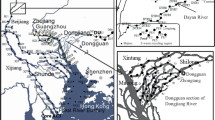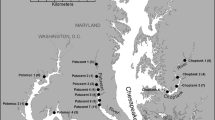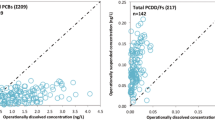Abstract
Sediment-bound polychlorinated biphenyls (PCBs) measured at several sites in the lower Hudson River Estuary are above equilibrium with the overlying water, providing a thermodynamic driving force for exchange from sediment to water. The fluxes of PCB congeners are estimated for a number potential processes: diffusive release of dissolved and colloidal PCBs from the bed, resuspension and subsequent desorption from resuspended particles, and sediment accumulation and burial. All processes are potentially significant, at least for some congeners. The sediment exchange fluxes of PCB solutes for five sites between Governors Island and Haverstraw Bay are estimated to be 20–860 μm m−2 d−1, which is between 2 and 100 times more than the flux of dissolved PCBs coming down the river at Haverstraw Bay. Much of the exchange from sediment to water may be balanced by burial of sorbed PCBs by sediment accumulation. Advection down the river and sediment exchange dominate other potential sources of PCBs to the lower estuary under current loading conditions. The magnitude of the calculated fluxes is consistent with the nonconservative behavior of PCBs in the same region but is higher than earlier modeling estimates that employed different assumptions.
Similar content being viewed by others
Literature Cited
Achman, D. R., K. C. Hornbuckle, andS. J. Eisenreich. 1993. Volatilization of PCBs from Green Bay, Lake Michigan.Environmental Science and Technology 27:75–87.
Battelle Ocean Sciences. 1993. Letter Date Report for Task II of Study of PCB in New York/New Jersey Point Sources, prepared under EPA Contract No. 68-C8-0105, January 1993.
Berner, R. A. 1980. Early Diagenesis. A Theoretical Approach. Princeton University Press, Princeton, New Jersey.
Boehm, P. D. 1981. Coupling of organic pollutants between the estuary and continental shelf and the sediments and water column in the New York Bight Region.Canadian Journal of Fisheries and Aquatic Sciences 40:262–276.
Bokuniewicz, H. J., J. Gebart, andR. B. Gordon. 1976. Sediment mass balance of a large estuary, Long Island Sound.Estuarine and Coastal Marine Science 4:523–536.
Bokuniewicz, H. J. and D. J. Hirschberg. 1982. Sediment-trapping efficiency of an estuary floor. Abstract number 041A-13,EOS 63:No. 18.
Bopp, R. F. andH. J. Simpson. 1989. Contamination of the Hudson River. The sediment record, p. 401–416.In Contaminated Marine Sediments—Assessment and Remediation. National Research Council, National Academy Press, Washington, D.C.
Bopp, R. F., H. J. Simpson, C. R. Olsen, andN. Kostyk. 1981. Polychlorinated biphenyls in sediments of the tidal Hudson River, New York.Environmental Science and Technology 15:210–216.
Brown, M. P., M. B. Werner, R. J. Sloan, andK. W. Simpson. 1985. Polychlorinated biphenyls in the Hudson River.Environmental Science and Technology 19:656–640.
Brownawell, B. J. 1986. The role of colloidal organic matter in the marine geochemistry of PCBs. PhD Dissertation, Massachusetts Institute of Technology/Woods Hole Oceanographic Institution Joint Program in Oceanography, Cambridge, Massachusetts.
Brownawell, B. J., D. R. Achmana, L. Zhang, N. Zhu, and B. Kaufman. 1994. Partitioning of PCBs in the water column of the Hudson River Estuary. Final report (contract 00290A003) to the Hudson River Foundation, New York City.
Brownawell, B. J. andJ. W. Farrington. 1985. Partitioning of PCBs in marine sediments, p. 97–120.In A. C. Sigleo and A. Hattori (eds.), Marine and Estuarine Geochemistry. Lewis Publishers, Inc., Chelsea, Michigan.
Brownawell, B. J. andJ. W. Farrington. 1986. Biogeochemistry of PCBs in interstitial waters of a coastal marine sediment.Geochimica et Cosmochimica Acta 50:157–169.
Capel, P. C., J. E. Baker, andS. J. Eisenreich. 1986. Influence of colloids on sediment-water partition coefficients of PCB congeners in natural waters.Environmental Science and Technology 20:1136–1143.
Carroll, K. M., M. R. Harkness, A. A. Bracco, andR. R. Balcarcel. 1994. Application of a permeant/polymer diffusional model to the desorption of polychlorinated biphenyls from Hudson River sediments.Environmental Science and Technology 28:253–258.
Chin, Y. P. andP. M. Gschwend. 1991. The abundance, distribution, and configuration of porewater organic colloids in recent sediments.Geochimica et Cosmochimica Acta 55:1309–1318.
Chiou, C. T., L. J. Peters, andV. H. Freed. 1979. A physical concept of soil-water equilibria for nonionic compounds.Science 206:831–832.
Chiou, C. T., P. E. Porter, andD. W. Schmedding. 1983. Partition equilibria of nonionic organic compounds between soil organic matter and water.Environmental Science and Technology 17:227–231.
Coates, J. T. andA. W. Elzerman. 1986. Desorption kinetics for selected PCB congeners from river sediments.Journal of Contaminant Hydrology 1:191–210.
Cooper, J. C., F. R. Cantelmo, andC. E. Newton. 1988. Overview of the Hudson River Estuary.American Fishery Society Monograph 4:11–24.
Di Toro, D. M. andL. M. Horzempa. 1982. Reversible and resistant components of PCB adsorption-desorption: Isotherms.Environmental Science and Technology 16:594–602.
Formica, S. J., J. A. Baron, L. J. Thibodeaux, andK. T. Valsaraj. 1988. PCB transport into lake sediments. Conceptual model and laboratory simulation.Environmental Science and Technology 22:1435–1440.
Hawker, D. W. andD. W. Connell. 1988. Octanol-water partition coefficients of polychlorinated biphenyl congeners.Environmental Science and Technology 22:382–387.
Hirschberg, D. J., P. Chin, H. Feng, andJ. K. Cochran. 1996. Dynamics of sediment and contaminated transport in the Hudson River estuary: Evidence from sediment distributions of naturally occurring radionuclides.Estuaries 19:931–949.
Jorgensen, B. B. andD. J. Des Marais. 1990. The diffusive boundary layer of sediments: Oxygen microgradients over a microbial mat.Limnology and Oceanography 35:1343–1355.
Karickhoff, S. W. 1984. Organic pollutant sorption in aquatic systems.Journal of Hydraulic Engineering 110:707–735.
Karickhoff, S. W., D. S. Brown, andT. A. Scott. 1979. Sorption of hydrophobic pollutants on natural sediments.Water Research 13:241–248.
Kineke, G. C. andR. W. Sternberg. 1989. The effect of particle settling velocity on computed suspended sediment concentration profiles.Marine Geology 90:159–174.
Krank, K. andT. G. Milligan. 1992. Characteristics of suspended particles at an 11-hour anchor station in San Francisco Bay, California.Journal of Geophysical Research 97:11,373–11,382.
Krom, M. D. andE. R. Sholkovitz. 1977. Nature and reactions of dissolved organic matter in the interstitial waters of marine sediments.Geochimica et Cosmochimica Acta 41:1565–1573.
Latimer, J. S. In Press. The significance of atmospheric deposition as a source of PCBs and PAHs to Narragansett Bay.In J. E. Baker (ed.), Atmospheric Deposition of Contaminants to the Great Lakes and Coastal Waters. Elsevier, Oxford, United Kingdom.
Limburg, K. E. 1986. PCBs in the Hudson, p. 83–125.In K. E. Limburg, M. A. Moran, and W. H. McDowell (eds.), The Hudson River Ecosystem. Springer-Verlag, New York.
Mueller, J. A., T. A. Gerrish, and M. C. Casey. 1982. Contaminant inputs to the Hudson-Raritan Estuary. National Oceanic and Atmospheric Administration Technical Memorandum OMPA-21, Boulder, Colorado.
Mullin, M. D. 1985. PCB workshop, United States Environmental Protection Agency, Large Lakes Research Station, Grosse Ile, Michigan.
Olsen, C. R., I. L. Larsen, R. H. Brewster, N. H. Cutshall, R. F. Bopp, and H. J. Simpson. 1984. A geochemical assessment of sedimentation and contaminant distributions in the Hudson-Raritan Estuary. National Oceanic and Atmospheric Administration Technical Report OMS NOS 2, Rockville, Maryland.
Olsen, C. R., H. J. Simpson, R. F. Bopp, S. C. Williams, T. H. Peng, andB. L. Deck. 1978. A geochemical analysis of the sediments and sedimentation in the Hudson Estuary.Journal of Sedimentary Petrology 48:401–418.
Paige, C. 1984. Downward Flux of Particles in LI Sound. M.S. Thesis. Marine Sciences Research Center, State University of New York, Stony Brook, New York.
Pignatello, J. J. 1990. Slowly reversible sorption of aliphatic halocarbons in soils: Mechanistic aspects.Environmental Toxicology and Chemistry 9:1,117–1,126.
Reid, R. C., J. M. Prausnitz, andB. E. Poling. 1987. The Properties of Liquids and Gases, 4th edition. McGraw-Hill, Inc., New York.
Santschi, P. H., R. F. Anderson, M. Q. Fleisher, andW. Bowles. 1991. Measurements of diffusive sublayer thicknesses in the ocean by alabaster dissolution, and their implications for the measurements of benthic fluxes.Journal of Geophysical Research 96:10,641–10,657.
Schwarzenbach, R., P. M. Gschwend, andD. M. Imboden. 1993. Environmental Organic Chemistry. John Wiley and Sons, Inc., New York.
Schwarzenbach, R. P. andJ. Westall. 1981. Transport of nonpolar organic compounds from surface water to groundwater. Laboratory sorption studies.Environmental Science and Technology 15:1,360–1,367.
Thomann, R. V., J. A. Mueller, R. P. Winfield, and C. R. Huang. 1989. Mathematical model of the long-term behavior of PCBs in the Hudson River Estuary. Report to the Hudson River Foundation, New York.
Thomann, R. V., J. A. Mueller, R. P. Winfield, andC.-R. Huang. 1991. Model of the fate and accumulation of PCB homologues in the Hudson Estuary, American Society of Civil Engineers.Journal of Environmental Engineering Division 117: 161–177.
Wu, S. andP. M. Gschwend. 1986. Sorption kinetics of hydrophobic organic compounds to natural sediments and soils.Environmental Science and Technology 20:717–725.
Wu, S. andP. M. Gschwend. 1988. Numerical modeling of sorption kinetics of organic compounds to soil and sediment particles.Water Resources Research 24:1,373–1,383.
Author information
Authors and Affiliations
Rights and permissions
About this article
Cite this article
Achman, D.R., Brownawell, B.J. & Zhang, L. Exchange of polychlorinated biphenyls between sediment and water in the Hudson River estuary. Estuaries 19, 950–965 (1996). https://doi.org/10.2307/1352310
Received:
Accepted:
Issue Date:
DOI: https://doi.org/10.2307/1352310




